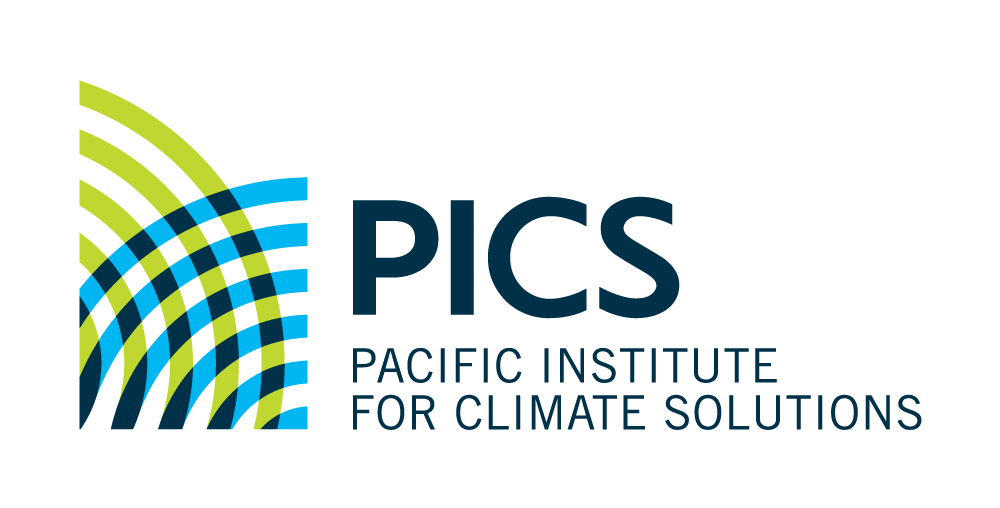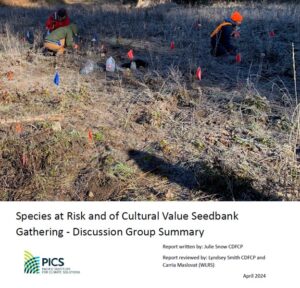Overview
The Coastal Douglas-fir Conservation Partnership (CDFCP), Ministry of Water, Land and Resource Stewardship (WLRS) and the UBC Botanical Garden hosted a virtual Species at Risk and of Cultural Value Seedbank Gathering on February 28th, 2024.
The purpose of the gathering was to work towards developing a roadmap for the establishment of a seedbank for species at risk and of cultural value in BC. The gathering brought together people from native plant nurseries (indigenous and non-indigenous), botanical gardens, herbaria, indigenous restoration practitioners, local, provincial and federal governments, NGO’s, scientists and researchers.
Objectives of the Gathering
The objectives for the gathering were to:
- Establish a network of knowledge holders and future collectors.
- Understand priorities for species to include in the seedbank.
- Understand support / capacity needed to establish and maintain the seedbank.
- Learn from others who have experience with species at risk or cultural value, seed collection and the storage of seed.
A Visual Summary of the Seed Banking Process:

Format of the Gathering
The gathering consisted of a series of speakers followed by four facilitated discussions held in breakout rooms. A recording and summary of each speaker’s presentation is provided. A summary of the facilitated discussions are also provided.
Summary of Gathering Discussion
Attendees at the gathering were asked four questions:
- Q1 – How are you able to contribute to a BC Seedbank project? Who else should be involved? What might the barriers be to your involvement?
- Q2 – What factors should be considered with prioritising a species for collection e.g. cultural importance, threat from development, climate sensitive ecosystem?
- Q3 – What aspects of the seed collection / processing / storage do you feel you or your team would like training on? Can your group provide training?
- Q4 – What resources do you think you need to be part of the seed network e.g. capacity, funding, materials, ID skills etc.
The summary presents key points made by attendees. A detailed discussion report has also been prepared as all thoughts and comments shared were recorded. This report can be accessed by contacting info@cdfcp.ca.
Recordings of the Gathering
Introduction and Context Setting
Lyndsey Smith of the Coastal Douglas-fir Conservation Partnership (CDFCP) and Carrina Maslovat of the BC Ministry of Land, Water and Resource Stewardship (WLRS) introduced the idea of the BC Seedbank and the goals of the Species at Risk and of Cultural Value Seedbank Gathering.
The purpose of the Species at Risk and of Cultural Value Seedbank Gathering was to develop a roadmap to establish and external (ex situ) seedbank for species at risk and of cultural value in BC. Other goals included knowledge sharing, network development, relationship building, species prioritization input and learning about each organizations needs.
We acknowledge the support that has been provided by Pacific Institute for Climate Solutions to host the gathering and our other funders that provided us with capacity to explore the seedbank concept. These funders include Environment and Climate Change Canada, UBC Botanical Garden, Nature Conservancy of Canada, Nature Trust BC, BC Ministry of Water, Land and Resource Stewardship and the Islands Trust.
Wendy Gibble, University of Washington: Rare Plant Care and Conservation
Wendy Gibble of the University of Washington Botanic Gardens shared information about the Miller Seed Vault and Rare Seed Collection at the University of Washington.
The Miller Seed Vault is a conservation seedbank focused on the long-term storage of imperilled species to safeguard against extinction and preserve unique genetic adaptations. Wendy described the key components of a conservation seedbank, conventional and cryopreservation methods, seed collection programs, the importance of data management, seed preparation, viability testing, and distribution policy.
A Conversation with Mary Knockwood from the NRCan National Tree Seed Centre and the Indigenous Seed Collection Program
In this conversation with Mary Knockwood (a Mi’gmaw woman and the Indigenous Programs Coordinator for Natural Resources Canada), we learned about her work with the Natural Tree Seed Centre’s Indigenous Seed Collection Program. She highlighted the program through the lens of black ash, a particularly important species to the Mi’gmaw People. She explained how the protection of plants is also interwoven with the preservation of associated ecosystems, language and cultural practices.
The Indigenous Seed Collection Program supports indigenous communities in their efforts to preserve species and their capacity to reintroduce species in the future. Part of this includes training and knowledge sharing in the areas of seed collection, seed processing and seed storage. The importance of respecting data sovereignty and creating of memoranda of understanding when working with indigenous communities was also discussed.
More information about the National Tree Seed Centre’s Indigenous Seed Program is available here.
James Miskelly, Satinflower Nurseries: Collecting for Native Seed Restoration
James Miskelly of Satinflower Nurseries described their program for the collection of native seeds. Satinflower Nurseries collects seeds for use in their own nursery, home gardeners and large-scale restoration projects.
James discussed current guidelines for ethical and safe seed collection as well as provenance considerations (i.e. where to collect in relation to where the seeds will be used). He also explores why these concepts are so important to preserving the genetic diversity of the collected plants with case studies.
Wendy Gibble, University of Washington:– Seed Collection for Long Term Storage in a Seedbank
Wendy Gibble of the University of Washington Botanic Gardens shared information about establishing a seed collection program for long-term storage.
She recommended following the guidelines provided in the Best Plant Conservation Practice to Support Species Survival in the Wild (Centre for Plant Conservation 2019). Consideration of the goals of the collection, seed collection guidelines and strategies, pre-collection monitoring and the importance of collecting along maternal lines were all explored.
Carrina Maslovat (WLRS): What are the needs and opportunities for a BC Species at Risk and of Cultural Value Seedbank
Carrina Maslovat of the BC Ministry of Land, Water and Resource Stewardship (WLRS) explored the needs and opportunities for the BC Species at Risk and of Cultural Value Seedbank. She reviewed prioritization aspects, threats to rare and culturally valuable BC plants and the value of seedbanks. She also reinforced that the BC Seedbank will rely on open collaboration and knowledge sharing. Next steps explored included: Where to the long-term storage facility should be located, the need to develop plant monitoring and seed collection programs and training and capacity needs.
Further Information
If you’d like any further information contact info@cdfcp.ca.
Acknowledgements
We would like to express our sincere gratitude to all of the speakers and participants of the gathering, who made the event a success and established a framework for future collaboration. We would also like to acknowledge the support that has been provided by our funders








